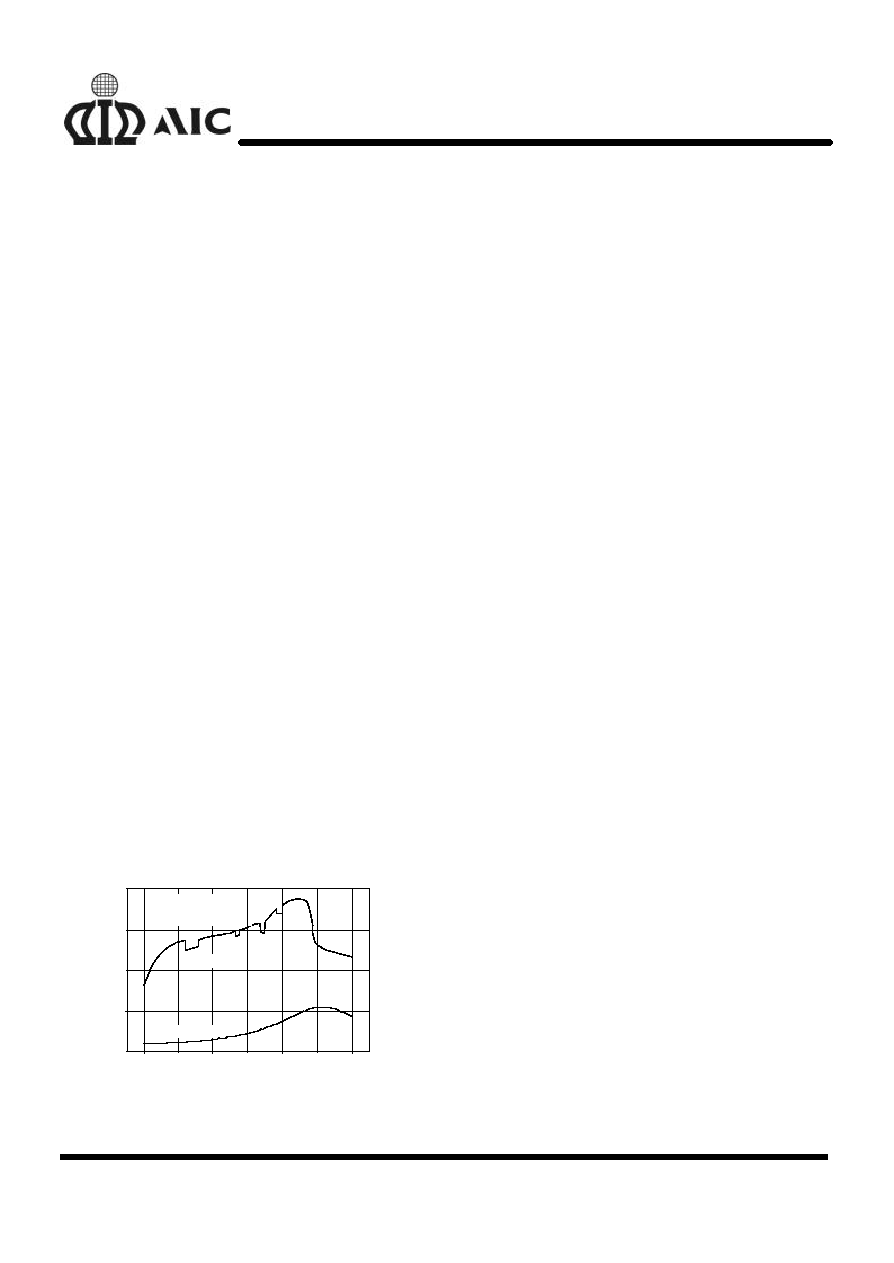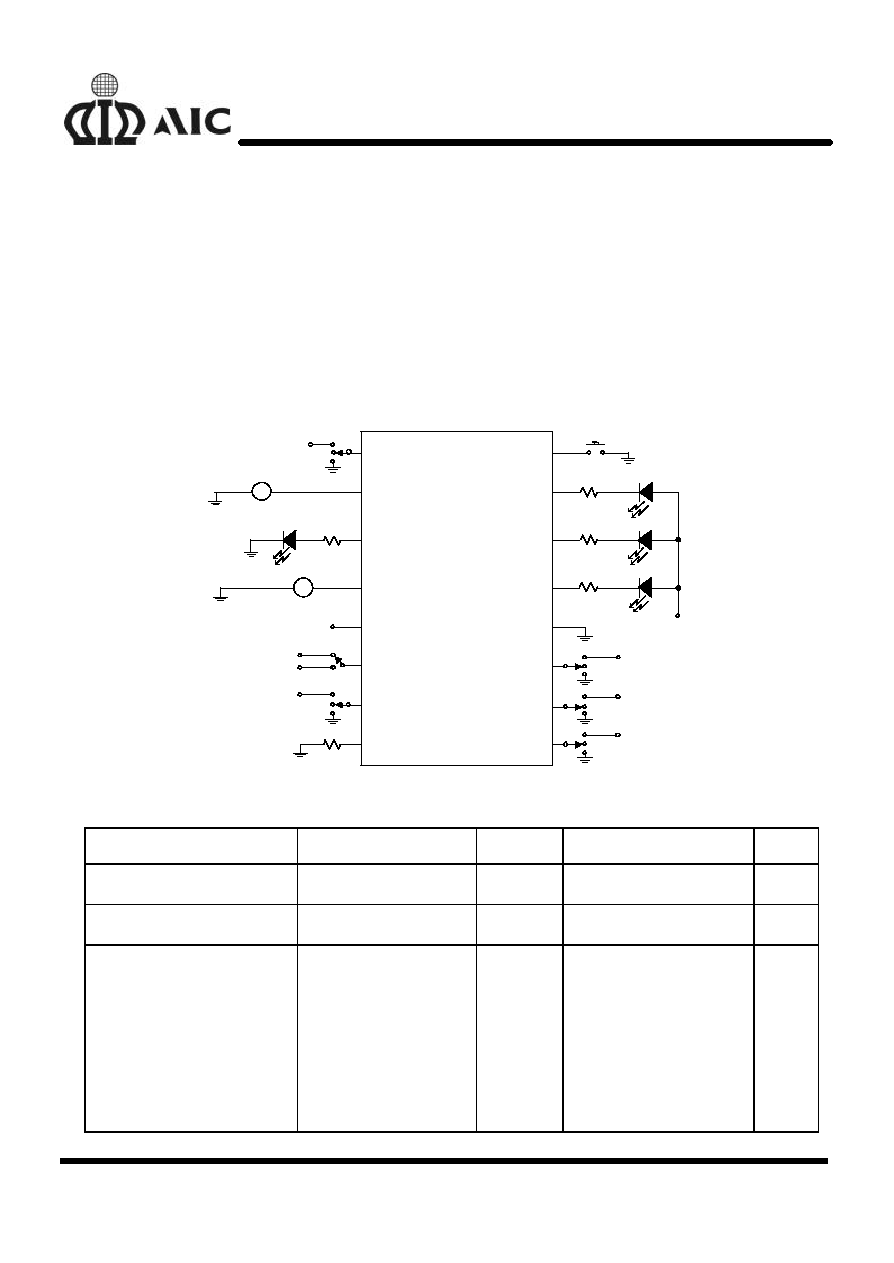
AIC1781
Battery Charge Controller
DS-1781-01 012102
1
n
FEATURES
l
Fast Charge Control of NiMH/NiCd Batteries,
even with a Fluctuating Charging Current.
l
Fast Charge Termination by:
T / t ,
-
V,
0 V
, Safety Timer, Maximum Temperature,
Maximum Voltage.
l
Linearly Adjustable
T / t Detection Slope and
Safety Timer.
l
Adjustable Peak Voltage Timer for 0 V
.
l
Battery Voltage Protection Range Selectable.
l
Selectable Battery Temperature Protection
Mode.
l
Protection against Battery Voltage and Battery
Temperature Faults.
l
Selectable LED Display Mode for Battery Status.
l
Five Pulsed Trickle Charge Modes.
l
Discharge-before-Charge Function Available for
Eliminating Memory Effect.
l
Quick and Easy Testing for Production.
l
16-pin DIP or SO Packages.
n
APPLICATIONS
Battery Fast Chargers for:
l
Mobile Phones.
l
Notebook and Laptop Personal Computers.
l
Portable Power Tools and Toys.
l
Portable Communication Equipments.
l
Portable Video & Stereo Equipments.
0
10
20
30
40
50
60
1.15
1.25
1.35
1.45
1.55
100
80
60
40
20
Temperature (
∞
C
)
Temperature
Cell Voltage
Cell Voltage (V)
Charge Time (min.)
Charge Current = 600 mA
Cell Capacity = 550 mA
NiMH Battery
Fig. 1 Battery Charging Characteristics Resulting from
an AIC1781-Controlled Charger with a
Fluctuating Charging Current
n
DESCRIPTION
The AIC1781 fast charge controller IC is designed
for intelligent charging of NiMH or NiCd batteries
without the risk of overcharge.
-
V detection
(-0.25%), 0 V
detection (peak voltage timer)
and
T / t detection are the primary methods
employed by the AIC1781 to terminate fast charge.
The fast charge can also be cut off by maximum
battery voltage and maximum battery temperature
detection along with the safety timer to prevent
charging under fault conditions of the charging
system or the battery itself.
Both
T / t and
-
V detection methods have
been proved powerful in terminating fast charging
for NiMH and NiCd batteries. The AIC1781 utilizes
the combination of these two methods to achieve
reliable decision of ending fast charge and prevent
misaction caused by using
-
V detection alone
under certain conditions. Fig. 1 shows an example
of charging curve of a battery charged by a
fluctuating current from a NiMH battery charger
which uses the AIC1781 controller IC to achieve
optimal charging. This technique, in cooperating
with the 0 V
detection (peak voltage timer), is
particularly suitable for NiMH batteries, whose
voltage drop is hardly significant yet temperature
rises rapidly. The
T / t or
-
V detection
circuitry may be disabled independently for
different applications, such as system-integrated
chargers, chargers with varying charge current, or
battery packs lack of temperature sensing
thermistor.
The safety timer period, mode of battery
temperature protection, battery voltage protection
range, pulsed trickle charge duty, and LED display
mode are all adjustable or selectable. Discharge-
before-charge function is included to get rid of

AIC1781
2
memory effect of NiCd batteries without the risk of
overdischarging. Test mode is provided for charger
manufactures to dramatically reduce production
test time.
n
TYPICAL APPLICATION CIRCUIT
PEAK
1
VBT
2
DIS
3
VTS
4
VCC
5
ADJ
6
SEL3
7
TMR
8
MODE
9
SEL2
10
SEL1
11
GND
12
LED1
13
LED2 14
ICON
15
DSW 16
U2
AIC1781
R8
300K
R9
91K
R10
100K
+
C9
4.7
µ
F
C7
0.1
µ
F
C10
47nF
R15
680
R3
270
R2
20/5W
SW1
PB SW
R12
100K
R16
680
R17
680
R14
200K
C8
0.
1
µ
F
+
C11
100
µ
F
RX
R11
100K
RY
C6
0.1
µ
F
R13
470K
Q2
MMBT2222A
R6
50K
LED2
GREEN
LED3
RED
LED1
YELLOW
Q1
MPS2222A
+
C4
220
µ
F
C5
0
.1
µ
F
+
C12
1
µ
F
+
C13
10
µ
F
R5 120/0.5W
R1
1K
BAT1
**
BATTERY
R7
THERMISTOR
VIN
11~15V
L1
220
µ
H
C2
1
µ
F
C1
470P
RS
0.3/1W
1
2
3
GND
4
FB
5
VCC
DC
DE
CF
6
IS
7
BOOST
8
U1
AIC1563
+
C3
220
µ
F
R4
390K
D3
IN4148
D1
IN4148
D2 IN5819
D4
1N5819
VIN
VOUT
GND
U3
78L05
**3~5 NiMH/NiCd cells.
Note: Charge Current=0.3/RS Ampere
Safety Timer: 80min
Battery Charge Circuit for Fluctuating Charging Current Application
n
ORDERING INFORMATION
1 6
1 4
1 5
1 0
1 2
1 1
1 3
PACKING TYPE
TR: TAPE & REEL
TB: TUBE
PACKAGE TYPE
N: PLASTIC DIP
S: SMALL OUTLINE
AIC1781 CXXX
Example: AIC1781CSTR
ý
in SO-16 Package & Tape & Reel
Packing Type
(CN is not available in TR packing type)
TOP VIEW
PIN CONFIGURATION
9
1
3
2
5
7
6
4
8
PEAK
VBT
DIS
VTS
VCC
ADJ
SEL3
SEL1
SEL2
MODE
LED1
GND
TMR
DSW
ICON
LED2

AIC1781
3
n
ABSOLUTE MAXIMUM RATINGS
Supply Voltage
............................................... ... ... ... ........................................ 5.5V
DC Voltage Applied on any pin ......................... ... ... ... ... ...................................... 5.5V
Sink current of ICON pin, LED1 and LED2 pin .......................... ... ... .................. 20mA
Operating Temperature Range ........................................ ... ... ... ... .............. 0
∞
C~ 70
∞
C
Storage Temperature Range ................................................ ... ... ... ...... -65
∞
C~ 150
∞
C
n
TEST CIRCUIT
PEAK
DSW
VBT
ICON
DIS
LED2
VTS
LED1
VCC
GND
ADJ
SEL1
SEL3
SEL2
TMR
MODE
V2 (3V)
V1 (0.95V)
V
CC
V
CC
(5V)
V
CC
GREEN
ORANGE
RED
560
AIC1781
R2
-
+
-
+
YELLOW
VOLTAGE
SOURCE
VOLTAGE SOURCE
V
CC
V
CC
V
CC
V
CC
100K
R1
560
560
R3
R4
560
R5
n
ELECTRICAL CHARACTERISTICS
(T
A
=25
∞
C, V
CC
=5V, unless otherwise specified.)
PARAMETER
TEST CONDITIONS
SYMBOL
MIN.
TYP.
MAX.
UNIT
Supply Voltage
V
CC
4.5
5.0
5.5
V
Supply Current
I
CC
1.1
mA
Battery Low
During Initial Timer
0.11
0.16
0.21
After Initial Timer
(SEL3>3V)
0.63
0.69
0.75
(SEL3<2V)
1.1
1.2
1.30
Battery High
(SEL3>3V)
2.6
2.7
2.80
Voltage Protection Limit
(SEL3<2V)
V
BT
1.9
2.0
2.10
V

AIC1781
4
n
ELECTRICAL CHARACTERISTICS
(Continued)
PARAMETER
TEST CONDITIONS
SYMBOL
MIN.
TYP.
MAX.
UNIT
Temperature High
1.35
1.45
1.55
Temperature Sense Limit
Temperature Low
V
TS
3.5
3.6
3.70
V
Output impedance of DIS Pin
Z
DIS
140
250
LED1, LED2, ICON pins
Output Impedance
ON
OFF
1
25
50
M
Source Current
Capability
SEL3 pin
DSW pin
I
SEL3
I
DSW
5.5
16
µ
A
MODE, PEAK, SEL1,
SEL2 pins
300
K
Input Impedance
VBT, VTS, ADJ pins
1
M
Recommended
External Resistor of TMR pin
R
TMR
2
100
1000
K
-
V Detection Level w.r.t.*
Peak Value
-0.25
%
* w.r.t.: with respect to
n
TYPICAL PERFORMANCE CHARACTERISTICS
(T
A
=25
∞
C, R2=100K
, V
CC
=5V,
refer to Test Circuit)
Fig. 2 Supply Current vs. Supply Voltage
4.4
4.6
4.8
5.0
5.2
5.4
1.00
1.06
1.12
1.18
1.21
Supply Current (mA)
V
CC
(V)
4.4
4.6
4.8
5.0
5.2
5.4
79.0
79.5
80.0
80.5
81.0
Fig. 3 Safety Timer vs. Supply Volatge
Safety Timer (min.)
V
CC
(V)

AIC1781
5
n
TYPICAL PERFORMANCE CHARACTERISTICS
(Continued)
4.4
4.6
4.8
5.0
5.2
5.4
3.8
4.0
4.2
4.4
4.6
4.8
Fig. 4 LED Flashing Frequency vs. Supply Voltage
Frequency (Hz)
V
CC
(V)
0
20
40
60
80
0.9
1.02
1.14
1.26
Fig. 5 Supply Current vs. Temperature
Supply Current (mA)
Temperature (
∞
C)
0
20
40
60
80
79.0
80.0
81.0
82.0
Fig. 6 Safety Timer vs. Temperature
Safety Timer (min.)
Temperature(
∞
C)
0
20
40
60
80
Fig. 7 LED Flashing Frequency vs. Temperature
3.4
3.8
4.2
4.6
5.0
Frequency (Hz)
Temperature(
∞
C)
0
20
40
60
80
2.62
2.66
2.70
2.74
Fig. 8 V
BT
(High) Limit vs. Temperature
(SEL3>3V)
V
BT
(V)
Temperature (
∞
C)
0
20
40
60
80
1.98
1.99
2.01
2.03
Fig. 9 V
BT
(High) Limit vs. Temperature
(SEL3<2V)
V
BT
(V)
Temperature (
∞
C)




